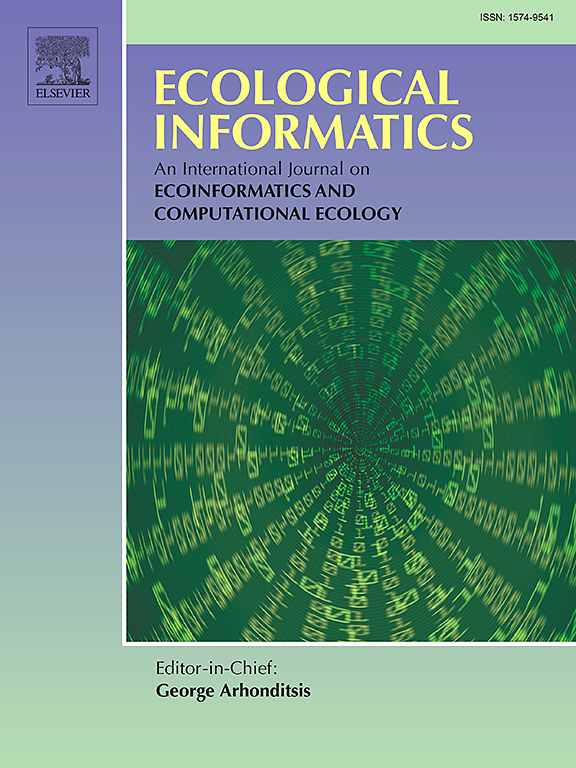利用卫星遥感建立林冠结构模型并开发林分健康指数
IF 5.8
2区 环境科学与生态学
Q1 ECOLOGY
引用次数: 0
摘要
生物和非生物干扰会改变树木结构,降低林分健康水平。准确的林分结构地理空间数据对于监测树木生长、森林健康、病虫害的发展和严重程度以及估计对气候压力的适应能力非常重要。树木的活冠率(LCR)是一项重要的健康指标,但利用遥感数据对景观层面的研究还不够。本研究利用卫星数据和地面观测相结合的方法,生成了叶面积指数(LAI)以及站点和景观尺度上活冠率的新型空间层。我们在美国缅因州四个以东部白松(EWP;Pinus strobus L.)为主的地点进行了实地调查,收集了地块级(10 m × 10 m)数据。利用微波(哨兵-1)和光学(哨兵-2)遥感数据,并应用随机森林(RF)和支持向量机(SVM)机器学习算法,利用地块级数据建立了估计 LAI 和 LCR 的回归模型。在站点层面,RF 模型的预测精度高于 SVM 模型。此外,使用 RF 模型对 LAI(R2 >0.76)和 LCR(R2 >0.71)的预测精度在地点和景观水平上相当。此外,预测的 LAI 和 LCR 与冠层高度和林分密度相结合,绘制了新的 EWP 健康指数图。所绘制的健康指数图成功地划分出了代表不同健康类别的斑块。林业从业人员和决策者可以利用得出的健康指数图和中间空间数据层(LAI 和 LCR)来指导林分管理。经进一步研究和验证,所开发的框架有可能应用于其他针叶树和阔叶树种,以进行基于遥感的LCR估算和森林健康评估。本文章由计算机程序翻译,如有差异,请以英文原文为准。
Modeling forest canopy structure and developing a stand health index using satellite remote sensing
Biotic and abiotic disturbances modify tree structure and degrade stand health. Accurate geospatial data on stand structure is important for monitoring tree growth, forest health, progression and severity of diseases and pests, and estimating resilience to climate stress. The live crown ratio (LCR) of trees serves as a key health indicator but has been understudied at the landscape level using remote sensing data. This study generated the leaf area index (LAI) and a novel spatial layer of LCR at site and landscape scales using a combination of satellite data and ground observations. We conducted field surveys to collect plot-level (10 m × 10 m) data in four eastern white pine (EWP; Pinus strobus L.)-dominated sites in the state of Maine, USA. The plot-level data were used to develop regression models for LAI and LCR estimation using microwave (Sentinel-1) and optical (Sentinel-2) remote sensing data and applying the Random Forest (RF) and Support Vector Machine (SVM) machine learning algorithms. The RF model showed higher prediction accuracy than the SVM model at the site level. Moreover, the prediction accuracy at the site and landscape levels were comparable for LAI (R2 > 0.76) and LCR (R2 > 0.71) using the RF model. Furthermore, the predicted LAI and LCR were integrated with canopy height and stand density to develop a novel health index map for EWP. The resulting health index map successfully delineated patches representing various health categories. Forestry practitioners and decision-makers can use the derived health index map and intermediate spatial data layers (LAI and LCR) to guide stand management. The developed framework can potentially be applied to other coniferous and broadleaved species for remote sensing-based LCR estimation and forest health assessment upon further studies and verification.
求助全文
通过发布文献求助,成功后即可免费获取论文全文。
去求助
来源期刊

Ecological Informatics
环境科学-生态学
CiteScore
8.30
自引率
11.80%
发文量
346
审稿时长
46 days
期刊介绍:
The journal Ecological Informatics is devoted to the publication of high quality, peer-reviewed articles on all aspects of computational ecology, data science and biogeography. The scope of the journal takes into account the data-intensive nature of ecology, the growing capacity of information technology to access, harness and leverage complex data as well as the critical need for informing sustainable management in view of global environmental and climate change.
The nature of the journal is interdisciplinary at the crossover between ecology and informatics. It focuses on novel concepts and techniques for image- and genome-based monitoring and interpretation, sensor- and multimedia-based data acquisition, internet-based data archiving and sharing, data assimilation, modelling and prediction of ecological data.
 求助内容:
求助内容: 应助结果提醒方式:
应助结果提醒方式:


